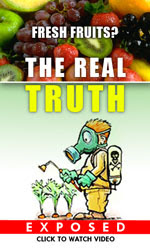 Heather Callaghan
Heather Callaghan
Activist Post
Netherlands researchers fear the second coming of Silent Spring
“Neonicotinoids were always regarded as selective toxins. But our results suggest that they may affect the entire ecosystem,” says Hans de Kroon of Radboud University and co-author of a study recently published in Nature journal.
It’s not just the bees. There are at least two ways that neonicotinoid pesticides dramatically affect the bird population.
Neonicotinoids are growing in the world market to become the most widely used pesticides and are often used to treat seeds – which makes the entire plant contain the chemical. (Yes, that means it doesn’t wash off) This might be useful to the farmer who wishes to target multiple pests such as those that eat roots and others that devour leaves, but that also means pollinators like bees get exposed to contaminated pollen, butterflies to nectar and birds can become immobilized or die after consuming treated seeds. Furthermore, they get into surface water in a variety of ways and build up and persist in the soil for years.
This study focused on multiple bird species that only consumed insects. So, we are talking about wildlife birds, which makes the findings even more perturbing to the researchers. It found that neonicotinoids affected their population in two ways: directly in large doses found in their waterways, and by killing off the insects that make up their food supply. They reminisce “the effects of persistent insecticides in the past” and highlight the “potential cascading effects of neonicotinoids on ecosystems.”
CBC News reports:
The researchers discovered the trend by looking at bird count data along with data about imidacloprid [a popular neonicotinoid] concentrations in waterways collected by the local water boards. While many bird species started declining before farmers started using imidacloprid in 1995, local differences in their decline didn’t appear until after that time.
The authors state:
At imidacloprid concentrations of more than 20 nanograms per litre, bird populations tended to decline by 3.5 per cent on average annually. Additional analyses revealed that this spatial pattern of decline appeared only after the introduction of imidacloprid to the Netherlands, in the mid-1990s.
Furthermore:
Recent studies have shown that neonicotinoid insecticides have adverse effects on non-target invertebrate species1, 2, 3, 4, 5, 6. Invertebrates constitute a substantial part of the diet of many bird species during the breeding season and are indispensable for raising offspring7
 While their findings on bird decline linked to neonicotinoids in water and through the unintended eradication of their food source are compelling – they stopped short of claiming direct cause. They do however, show that the correlation wasn’t a coincidence. They are building a line of evidence and joining up with other scientists who have reported similar findings with other animals. Common explanations such as population changes, crop changes and urbanization did not hold water under their battery of tests.
While their findings on bird decline linked to neonicotinoids in water and through the unintended eradication of their food source are compelling – they stopped short of claiming direct cause. They do however, show that the correlation wasn’t a coincidence. They are building a line of evidence and joining up with other scientists who have reported similar findings with other animals. Common explanations such as population changes, crop changes and urbanization did not hold water under their battery of tests.
Kroon said:
Our analysis shows that based on our data imidacloprid was by far the best explanatory variable for differences in trends between areas.
He told BBC:
In 10 years, it’s a 35% reduction in the local population. It’s really huge. It means the alarm bells are on straight away.
Bayer CropScience, leading maker of imidacloprid adamantly denied the study findings, emphasizing lack of direct cause and “substantiated evidence.” In a response, they wrote: “Neonicotinoids have gone through an extensive risk assessment which has shown that they are safe to the environment when used responsibly according to the label instructions.” This is an all-too-common retort that seems to attempt placing the smoking gun in farmers’ hands.
Lo and behold, Bayer is a part of the consortium funding an upcoming Canada-wide study to discover what’s harming the bees. Hint: not their product.
After the response from Bayer, they explained that for a direct cause to be determined, they would have to do landscape-scale experiments that would be difficult and probably very unethical.
But it is not only environmental chemicals to consider for the bird populations – birds are literally losing their way – due to overpowering EMF signals. Interestingly, the symptoms of birds caught in EMF waves and the ingestion of neonicotinoid seeds are similar – difficulty flying, immobilization. That is what the EPA discovered in 1992 while studying the pesticides’ effects on birds. This, however, did not lead to any thoughtful halt on the chemical approval before it entered the market.
The European Union recently enacted a temporary moritorium on neonicotinoids – but not without fierce fighting from the world’s biggest chemical producers – including Bayer.
Heather Callaghan is a natural health blogger and food freedom activist. You can see her work at NaturalBlaze.com and ActivistPost.com. Like at Facebook.
Recent posts by Heather Callaghan:


Be the first to comment on "Two Ways Bird Declines Are Linked to Chemical Pesticides"